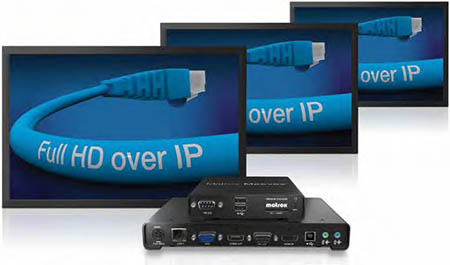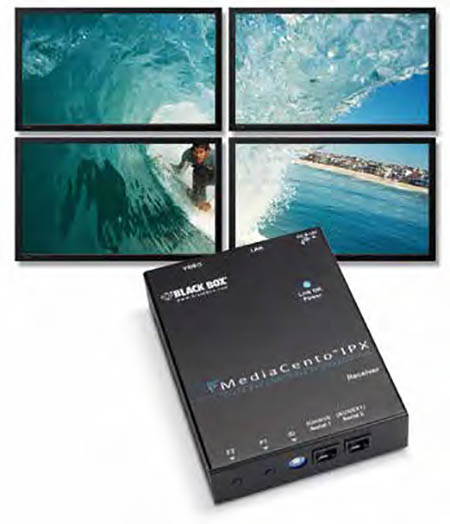Integrators Discuss Growth in AV as a Network Appliance

The Matrox Maevex H264 Encoder/ Decoder utilizes IP to allow multiple signals to travel on the same wire over a network. The brave new world of streaming AV over IP would surely cause Ma Bell to gaze over her wall of point-to-point connections in bewilderment.
Our collective fascination with interconnectivity in audio and visual communications began long before the dawn of the technology era, but it’s fast becoming part of the AV integrator’s reality. Early inventors like Alexander Graham Bell foresaw the merging of A with V in nineteenth-century writings and sketches. Now, the point-to-point connections pioneered and popularized by Bell’s audio telephone technology are yielding to streaming communication signals that a large number of users can receive over Ethernet-based IP.
“The new and cost-reduced advantages of AV over IP allow multiple signals to travel on the same wire and anywhere over the network,” said Ron Berty, business development manager at Matrox Graphics, “addressing the classic costs and limitations of the typical baseband matrix switch type of setup. Additionally, it allows for easy and more simplified expansion, recording, storage and access to the AV signals and content.”
Using IP to route AV streams can increase a user’s ability to connect with others for business, worship, learning and other applications, especially where traditional point-to-point connections simply aren’t viable solutions.
“An eight-port switch will never support more than eight end points,” said Harry Ostaffe, director of marketing at Black Box. “When exceeding this number, the whole system will have to be replaced, or multiple switching devices will have to be cascaded. With advanced system control, any source can be routed to any screen.”
The most viable ways to explore AV over IP technology today are in deploying HD video signals to numerous displays within a single structure, and for streaming AV to multiple remote sites as opposed to local displays.

The Hong Kong Civil Aviation Department uses Matrox Maevex H.264 encoder and decoder devices to stream live, low-bandwidth aircraft traffic footage 2 km (1.2 mi) from the Hong Kong International Airport to its Education Path aviation gallery. “The largest single growth opportunity when you start leveraging ethernet infrastructure to distribute audio and video is that it’s practical to stream over large distances,” said Tom Barnett, director of marketing communications at Crestron.
A daily selection of the top stories for AV integrators, resellers and consultants. Sign up below.
Barnett said that integrators can offer broader usability by sending AV signals over IP, such as linking any AV device for display on the network, but contends that the main excitement is being able to take any of those sources and send them anywhere in the world–or perhaps more commonly, from businesses to clients and satellite offices, or across a campus.
“In higher education 10 or 15 years ago, they would pick two rooms that might need to share content and run point-to-point wiring for AV,” Barnett said. “But with streaming, you can add input and output from every classroom, and if the university president wants to run an announcement, then anyone could plug in across campus.”
Barnett explained that it’s important to understand when AV over IP is the ideal solution and when to use point-to-point wiring.
“When you have five or six connections running, those connections are high bandwidth and low latency,” said Barnett. “For anything inside a room under that 300-foot range, you probably want to [use pointto- point]. You want to leverage AV over IP where it makes sense and take advantage of the reduction in costs.”
Still, choosing to route AV signals over IP rather than traditional means doesn’t have to be an either/or situation. Users can still use existing technology while jumping on the ethernet IP network selectively.
For many AV users with legacy systems, there are fewer challenges to leveraging the IP network than they might expect. AV over IP can expand those systems’ reach and allow them to grow in new ways. However, the fundamentals like choke points, scalability and media quality still apply.
“Bandwidth is the key limiting factor here,” said Rick Seegull, senior VP of sales and marketing at Aurora Multimedia. “As current technology allows us to move HD 720/1080P signals, the video market is a-buzz with 4K. This means the 1G network we are all currently using needs to jump to 10G for sure.”

Black Box’s MediaCento IPX PoE multicast transmitter allows users to send video over an IP network to an unlimited number of screens. Since ultra-high definition 4K is here and will likely increase in prominence as the consumer market adapts, SVSi’s Bob Sharp recommends integrators and users think ahead and install more capable networks rather than pulling additional cable later to expand the system. In the meantime, the main issue with 4K technology is upscaling.
“If you take 1080p and send it to a 4K display, the upscaling can leave image artifacts,” said Sharp, director of international sales at SVSi. “If you avoid scaling, you can avoid those problems. 4K makes sense if the content is available, but it’s inevitable and it’s coming.”
As AV over IP continues to become a reality in more spaces, the role of an AV integrator could veer toward aesthetician, consultant and proving a business case rather than moving AV around a building. The key, according to Sharp, is to understand where the value of an integrator lays versus IT managers and other technology positions.
“The value is no longer having the ability to move the video or audio around a building, it’s the look and feel, the usability, the front-facing side of that installation, how economic it is and how easy it is to use as intended,” said Sharp.
“The AV industry needs to embrace the design, the problem solving, working with architects and interior designers to see the trends in room design, like seeing small huddle rooms rather than large, sophisticated conference rooms. The value add of the AV guy is to move through those trends and make the rooms as elegant as possible without getting hung up on the black magic of being able to get media from point A to point B.”
Jim Beaugez, APR, is a freelance writer and accredited communications professional with a decade of experience in the MI and pro audio industries. You can reach him at jimbeaugez@gmail.com and on Twitter@JimBeaugez.
Jim Beaugez is a freelance writer and content creator for the AV, professional audio, and music industries. His work has been published by Systems Contractor News, Pro Sound News, Mix, Radio World, and The Recording Academy, as well as Rolling Stone, Smithsonian, Guitar World, Guitar Player, and other consumer publications. He previously worked in communications for the pro audio and musical instruments industries.
